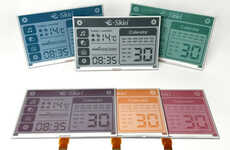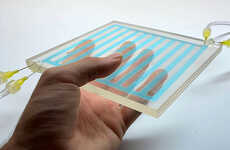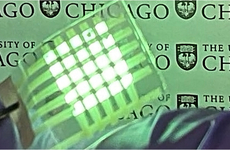
Opalux Color-Changing P-Ink Technology
Michael Plishka — December 24, 2008 — Tech
References: opalux & newscientist
British and Canadian Scientists have developed a polymer that contains layers that shrink and swell in response to electrical currents.
The result?
The material changes colors on demand, and can assume any color of the visible spectrum. It is similar in design to an opal in nature, but the results are obviously more controllable.
According to research team member Ian Manners at the University of Bristol in the United Kingdom, “The polymer is crucial to the whole thing. It contains iron atoms which can exist in two oxidative states. The more you oxidise the system the more it swells.” As the voltage is increased, more iron gets oxidized which results in more swelling, and hence there is a greater shift into the red.
While one use for this technology is full color electronic paper, I think it would be simple enough to tie this into a ring with a power source...a programmable mood ring.
The result?
The material changes colors on demand, and can assume any color of the visible spectrum. It is similar in design to an opal in nature, but the results are obviously more controllable.
According to research team member Ian Manners at the University of Bristol in the United Kingdom, “The polymer is crucial to the whole thing. It contains iron atoms which can exist in two oxidative states. The more you oxidise the system the more it swells.” As the voltage is increased, more iron gets oxidized which results in more swelling, and hence there is a greater shift into the red.
While one use for this technology is full color electronic paper, I think it would be simple enough to tie this into a ring with a power source...a programmable mood ring.
Trend Themes
1. Color-changing Polymers - The development of color-changing polymers that change in response to electrical current or other stimuli creates opportunities for novel methods of color customization in a range of products.
2. Electroactive Polymers - The use of polymers that respond to electrical current can be used to create materials that change in response to user input and could lead to improved interfaces and interactive products.
3. Smart Wearables - The incorporation of electroactive polymers into wearable devices, such as smart rings and mood bracelets, could create a new generation of responsive, customizable and fashionable technology products.
Industry Implications
1. Electronics - The electronics industry can leverage color-changing polymers to create new types of screens, sensors and user interfaces for consumer products.
2. Fashion - The fashion industry can develop smart clothing and accessories features with color-changing abilities for improved user experiences and personalization.
3. Printing - The printing industry can adopt this technology for applications such as posters, packaging and labels, to create interactive and dynamic products.
3.3
Score
Popularity
Activity
Freshness























